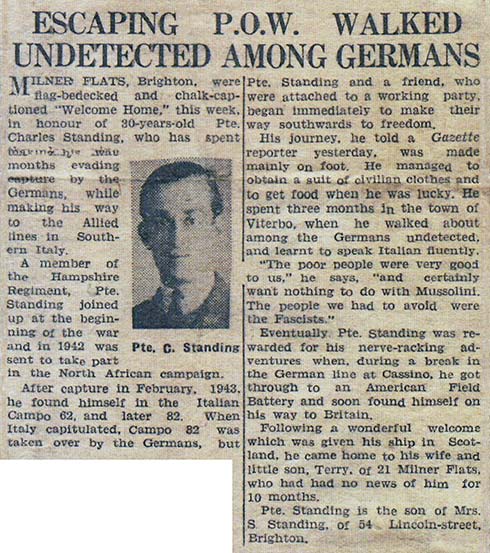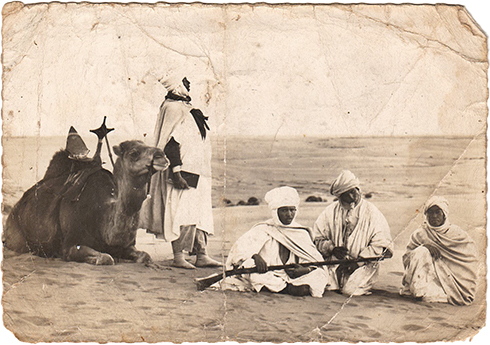
Charlie’s brother Fred Standing (left) and Charlie in the doorway of their family’s home at 54 Lincoln Street, Brighton.
This month I received a note from Simon Hasler of Brighton, UK, addressed to Gillian Pink.
Gill’s father, Tom Ager, was a prisoner-of-war in Italian camp P.G. 82. Tom’s story is recounted on this site in several posts (read “Thomas Ager—Escapee from Italian Camp 82,” “On the Sheltering of Tom Ager,” “Unexpected Letter—News of Tom Ager,” and “Greetings Sent Via the Vatican.”)
Simon wrote, “your post really resonates with our family. My wife’s granddad was in the same POW camp as your father and left at the same time. His name was Charlie Standing. He was a private from Brighton, but in the Hampshire regiment.
“His story is almost identical, other than he stayed uncaptured.
“He lived in caves and was helped by locals near Viterbo. He even learnt Italian whilst on the run and mingled with locals whilst German soldiers were around.
“We also have a Vatican note and other similar things. Charlie was captured in Sidi Nsir, Tunisia, imprisoned in Capua initially, before being moved to your father’s camp.
“We know he went [from Camp 82] with a P.O.W. from Devon area (which could have been Bristol potentially).
“I’m pretty sure it took the Germans two days to arrive after the Armistice, and the POWs that remained, which was most, were sent to a Stalag camp.
“When Charlie got back to Brighton he was interviewed for a local paper, the Brighton Gazette. We still have the article. [See below.]
“We would love to hear from you, please, as Tom and Charlie may well have known each other and perhaps left together.”
Simon sent scans of several items, which are posted here. On the back of an old postcard are penciled three names: Settimio Galloni, Madalena Lido, and Madaleina Adelfa.
I suggested these might be Italians who helped Charlie in Viterbo.
Simon replied, “The three Italian names we don’t know, but we, like you, feel they are likely to be Italian helpers. He may well have been looked after by these.
“My father-in-law, Terry Standing, said he remembers seeing a letter Charlie received from someone in the Bristol area in the 50’s. The person wanted to meet with Charlie and return to Italy but this did not happen. He does not think he even met up with the Bristol guy.
“Terry seems to think the letter mentioned different people they knew in Italy, and had a mention of Viterbo, but as it’s so long ago that’s all the info he remembers.
“Charlie never told anyone much about his time in the war, although he did always say Italy was a beautiful country.”
“After escaping and then going it alone, he made his way south towards Rome, as he was told/thought the Allied forces were there. He eventually met up with Mark Clark’s U.S. army unit near Rome.”
I put Simon in touch with Gill and the two exchanged emails.
“I would love to think your grandfather-in-law and Charlie knew each other and maybe even escaped together, but I guess we’ll never know,” Gill wrote.
If the two knew each other—and perhaps even left the camp together—we can be sure they soon parted ways. From Arezzo, Tom Ager traveled northward and was sheltered in Premilcuore, nearly 100 kilometers north of P.G. 82. Charlie Standing moved in the opposite direction and found help in Viterbo, about 160 kilometers south of the camp.

This family photo shows Charlie, his wife Tup, their son Terry, and the family dog Spot. It was taken at Roedean Pitch & Putt. Simon writes of the location, “You could get an identical picture today of exactly the same spot—it’s unchanged.”
“Charlie got put on a ship to Scotland and then, after a week or two with Tup & Terry in their flat in Brighton, Milner Flats, he was stationed at Fullwood Barracks, Preston,” Simon explained.
“Terry was 3 or 4 when Charlie finally got back to UK. Terry said he still remembers meeting him the day he got back, which would have been his first actual memory of his dad.
“Because he was an escaped POW, Charlie was not allowed to return to Italy.
“He then worked for British Rail before retiring. The family remained in Brighton all of their lives—as has Terry and his wife Victoria, and my wife Kelly (Charlie’s granddaughter) and myself.
“Charlie chose not to apply for any of his medals.
“Charlie died of old age in November 1999, and Tup died in January 2013. They were both lovely, kind people—family focused.
“Charlie had four brothers in total, all dead now. The photo [of Charlie with his brother Fred, above] was taken at 54 Lincoln Street, Brighton. The house is still there and we have driven past it, though never knocked on the door.
“Terry thinks there is a buried motorbike in the back garden, as the brothers buried it before the war or as the war started, so it was not taken away. It may still be there, it would be nice to know that.”
Simon added, “My son Elliott is a budding moviemaker and is in the middle of making a film about Charlie. As part of his research he picked up your post.
“He actually did this work when he was 14 and we have stopped him doing it this year because of GCSE’s [General Certificate of Secondary Education examinations). It should be worthy of a film festival when it is finished, so that’s the plan.”
Simon directed me to a trailer for the film, Charlie’s Letters, on YouTube (www.youtube.com/watch?v=c3wJ9HXNaZE).
“Please feel free to pass the trailer on to any contacts you feel would like to know about young film making talent. Elliott would appreciate it.”
Here is the Brighton Gazette article Simon referred to:

Escaping P.O.W. Walked Undetected Among Germans
Brighton Gazette, circa spring 1944
MILNER FLATS, Brighton, were flag-bedecked and chalk-captioned “Welcome Home,” this week, in honour of 30-years-old Pte. Charles Standing, who has spent months evading capture by the Germans, while making his way to the Allied lines in Southern Italy.
A member of the Hampshire Regiment, Pte. Standing joined up at the beginning of the war and in 1942 was sent to take part in the North African campaign.
After capture in February, 1943, he found himself in the Italian Campo 62, and later 82. When Italy capitulated, Campo 82 was taken over by the Germans, but Pte. Standing and a friend, who were attached to a working party, began immediately to make their way southwards to freedom.
His journey, he told a Gazette reporter yesterday, was made mainly on foot. He managed to obtain a suit of civilian clothes and to get food when he was lucky. He spent three months in the town of Viterbo, when he walked about among the Germans undetected, and learnt to speak Italian fluently.
“The poor people were very good to us,” he says, “and certainly want nothing to do with Mussolini. The people we had to avoid were the Fascists.”
Eventually Pte. Standing was rewarded for his nerve-racking adventures when, during a break in the German line at Cassino, he got through to an American Field Battery and soon found himself on his way to Britain.
Following a wonderful welcome which was given his ship in Scotland, he came home to his wife and little son, Terry, of 21 Milner Flats, who had no news of him for 10 months.
Pte. Standing is the son of Mrs. S. Standing, of 54 Lincoln-street, Brighton.


Postcard of a North African group. In French, it reads “COLLECTION SAHARIENNE / 25 – Un peu de repos en musique. On the back of the card are written the Italian names Settimio Galloni, Madalena Lido, and Madaleina Adelfa.

Photograph taken in the North African desert, probably by Charlie or a comrade.
You can see archival photos of P.G. 82 on the valdarnopost.it website.
